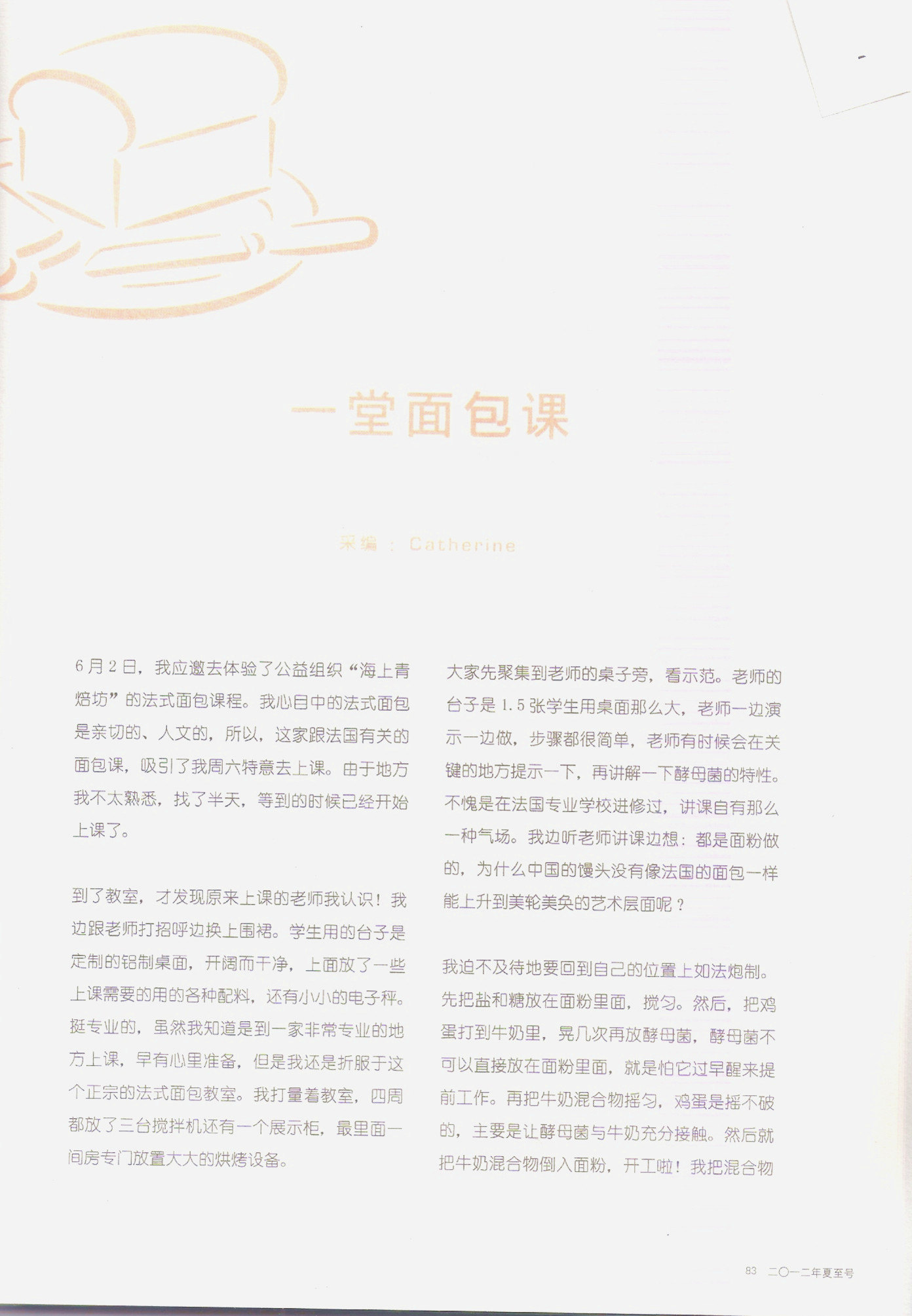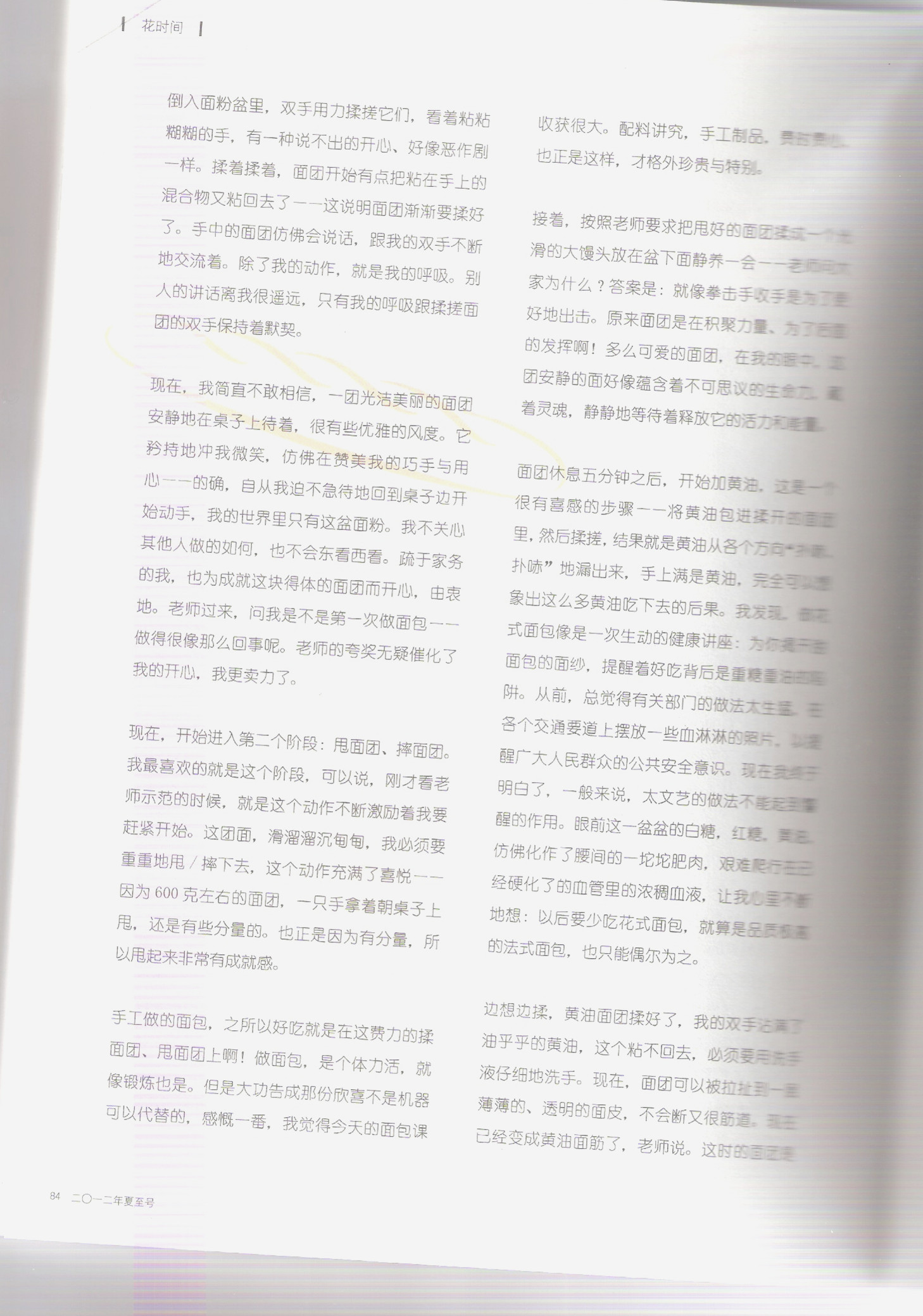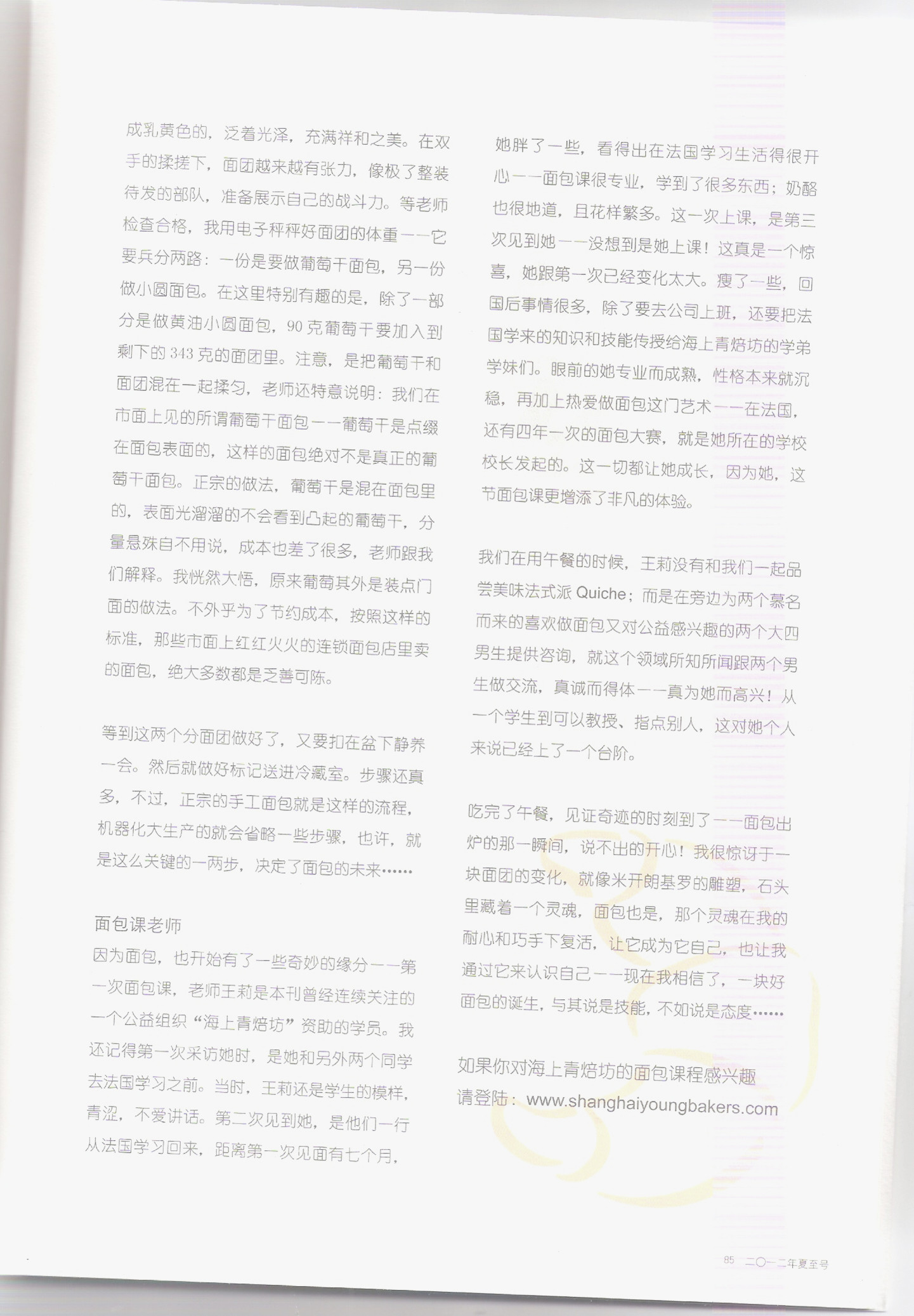


一堂面包课
文:Catherine
6月2日,我应邀去体验了公益组织“海上青焙坊”的法式面包课程。我心目中的法式面包是亲切的、人文的,所以,这家跟法国有关的面包课,吸引了我周六特意去上课。由于地方我不太熟悉,找了半天,等到的时候已经开始上课了。
到了教室,才发现原来上课的老师我认识!我边跟老师打招呼边换上围裙。学生用的台子是定制的铝制桌面,开阔而干净,上面放了一些上课需要的用的各种配料,还有小小的电子秤。挺专业的,虽然我知道是到一家非常专业的地方上课,早有心里准备,但是我还是折服于这个正宗的法式面包教室。我打量着教室,四周都放了三台搅拌机还有一个展示柜,最里面一间房专门放置大大的烘烤设备。
大家先聚集到老师的桌子旁,看示范。老师的台子是1.5张学生用桌面那么大,老师一边演示一边做,步骤都很简单,老师有时候会在关键的地方提示一下,再讲解一下酵母菌的特性。不愧是在法国专业学校进修过,讲课自有那么一种气场。我边听老师讲课边想:都是面粉做的,为什么中国的馒头没有像法国的面包一样能上升到美轮美奂的艺术层面呢?
我迫不及待地要回到你的位置上如法炮制。先把盐和糖放在面粉里面,搅匀。然后,把鸡蛋打到牛奶里,晃几次再放酵母菌,酵母菌不可以直接放在面粉里面,就是怕它过早醒来就开始工作。再把牛奶混合物摇匀,鸡蛋是摇不破的,主要是让酵母菌与牛奶充分接触。然后就把牛奶混合物倒入面粉,开工啦!我把混合物倒入面粉盆里,双手用力揉搓它们,看着粘粘糊糊的手,有一种说不出的开心、好像恶作剧一样。揉着揉着,面团开始有点把粘在手上的混合物又粘回去了——这说明面团渐渐要揉好了。我觉得面团是会说话的,跟你的双手不断地交流着。除了我的双手,就是我的呼吸。别人的讲话离我很遥远,只有我的呼吸跟揉搓面团的双手保持着默契。
现在,我简直不敢相信,一团光洁美丽的面团安静地在桌子上待着,很有些优雅的风度。它矜持地冲我微笑,仿佛在赞美我的巧手与用心——的确,自从我迫不急待地回到桌子边开始动手,我的世界里只有这盆面粉。我不关心其他人做的如何,也不会东看西看。疏于家务的我,也为成就这块得体的面团而开心,由衷地。老师过来,问我是不是第一次做面包——做得很像那么回事呢。老师的夸奖无疑催化了我的开心,我更卖力了。
现在,开始进入第二个阶段:甩面团、摔面团。我最喜欢的就是这个阶段,可以说,刚才看老师示范的时候,就是这个动作不断激励着我要赶紧开始。这团面,滑溜溜沉甸甸,我必须要重重地甩/摔下去,这个动作充满了喜悦——因为600克左右的面团,一只手拿着朝桌子上甩,还是有些分量的。也正是因为有分量,所以甩起来非常有成就感。
手工做的面包,之所以好吃就是在这费力的揉面团、甩面团上啊!做面包,是个体力活,就像锻炼也是。但是大功告成那份欣喜不是机器可以代替的,感慨一番,你觉得今天的面包课收获很大。配料讲究,手工制品,费时费心,也正是这样,才格外珍贵与特别。
接着,按照老师要求你把甩好的面团揉成一个光滑的大馒头放在盆下面静养一会——老师问大家为什么?答案是:就像拳击手收手是为了更好地出击。原来面团是在积聚力量、为了后面的发挥啊!多么可爱的面团,在你的眼中,这团安静的面好像蕴含着不可思议的生命力,藏着灵魂,静静地等待着释放它的活力和能量。
面团休息五分钟之后,开始加黄油,这是一个很有喜感的步骤——将黄油包进揉开的面团里,然后揉搓,结果就是黄油从各个方向“扑哧、扑哧”地漏出来,手上满是黄油,完全可以想象出这么多黄油吃下去的后果。我发现,做花式面包像是一次生动的健康讲座:为我揭开甜面包的面纱,提醒着好吃背后是重糖重油的陷阱。从前,总觉得有关部门的做法太生猛,在各个交通要道上摆放一些血淋淋的照片,以提醒广大人民群众的公共安全意识。现在我终于明白了,一般来说,太文艺的做法不能起到警醒的作用。眼前这一盆盆的白糖,红糖,黄油,仿佛化作了腰间的一坨坨肥肉,艰难爬行在已经硬化了的血管里的浓稠血液,让我心里不断地想:以后要少吃花式面包,就算是品质极高的法式面包,也只能偶尔为之。
边想边揉,黄油面团揉好了,我的双手沾满了油乎乎的黄油,这个粘不回去,必须要用洗手液仔细地洗手。现在,面团可以被拉扯到一层薄薄的、透明的面皮,不会断又很筋道。现在已经变成黄油面筋了,老师说。这是的面团是成乳黄色的,泛着光泽,充满祥和之美。在双手的揉搓下,面团越来越有张力,像极了整装待发的部队,准备展示自己的战斗力。等老师检查合格,我用电子秤秤好面团的体重——它要兵分两路:一份是要做葡萄干面包,另一份做小圆面包。在这里特别有趣的是,除了一部分是做黄油小圆面包,90克葡萄干要加入到剩下的343克的面团里。注意,是把葡萄干和面团混在一起揉匀,老师还特意说明:我们在市面上见的所谓葡萄干面包——葡萄干是点缀在面包表面的,这样的面包绝对不是真正的葡萄干面包。正宗的做法,葡萄干是混在面包里的,表面光溜溜的不会看到凸起的葡萄干,分量悬殊自不用说,成本也差了很多,老师跟我们解释。我恍然大悟,原来葡萄其外是装点门面的做法。不外乎为了节约成本,按照这样的标准,那些市面上红红火火的连锁面包店里卖的面包,绝大多数都是乏善可陈。
等到这两个分面团做好了,又要扣在盆下静养一会。然后就做好标记送进冷藏室。步骤还真多,不过,正宗的手工面包就是这样的流程,机器化大生产的就会省略一些步骤,也许,就是这么关键的一两步,决定了面包的未来……
面包课老师
因为面包,也开始有了一些奇妙的缘分——第一次面包课,老师王莉是本刊曾经连续关注的一个公益组织“海上青焙坊”资助的学员。我还记得第一次采访她时,她和另外两个同学去法国学习之前。当时,王莉还是学生的模样,青涩,不爱讲话。第二次见到她,是他们一行从法国学习回来,距离第一次见面有七个月,她胖了一些,看得出在法国学习生活得很开心——面包课很专业,学到了很多东西;奶酪也很地道,且花样繁多。这一次上课,是第三次见到她——没想到是她上课!这真是一个惊喜,她跟第一次已经变化太大。瘦了一些,回国后事情很多,除了要去公司上班,还要把法国学来的知识和技能传授给海上青焙坊的学弟学妹们。眼前的她专业而成熟,性格本来就沉稳,再加上热爱做面包这门艺术——在法国,还有四年一次的面包大赛,就是她所在的学校校长发起的。这一切都让她成长,因为她,这节面包课更增添了非凡的体验。
我们在用午餐的时候,王莉没有和我们一起品尝美味法式派Quiche;而是在旁边为两个慕名而来的喜欢做面包又对公益感兴趣的两个大四的男生提供咨询,就这个领域所知所闻跟两个男生做交流,真诚而得体——真为她而高兴!从一个学生到可以教授、指点别人,这对她个人来说已经上了一个台阶。
吃完了午餐,见证奇迹的时刻到了——面包出炉的那一瞬间,说不出的开心!你会惊讶于一块面团的变化,就像米开朗基罗的雕塑,石头里是藏着一个灵魂,你觉得面包也是,那个灵魂在你耐心和巧手下复活,让它成为它自己,也让你通过它来认识自己——现在我相信了,一块好面包的诞生,与其说是技能,不如说是态度……
如果你对海上青焙坊的面包课程感兴趣,请登陆:www.shanghaiyoungbakers.com
A Bread-Making Class
By Catherine
On June 2, I was invited to take a French baking course provided by the charity organization Shanghai Young Bakers. French bread is, to me, warm and with a touch of humanism. So I was attracted by the course and went to it especially on Saturday. But I didn’t know well where the course was held. It took me a long time to find the place and by then the course had already begun.
It was not until I got to the classroom that I found out I actually knew the teacher! I said hello to her as I put on the apron. The table the students used was made of aluminum. It was made to order. The table was broad and clean. There were various ingredients that were to be used later and small electronic scales on the table. Everything was professional. Although I had known the place I was going to was very professional and I was prepared for it, this traditional French baking classroom still compelled me with admiration. I looked around to see three whips and a showcase about. Large baking machines were kept in a distant room far in the classroom.
First, we gathered around the teacher’s table, which was 1.5 times the size of ours, to see the demonstration. She showed us while she was making the bread. All the steps were simple. Besides, the teacher would remind us at critical point. She also told us the characteristics of the yeast. She really proved herself to have taken advanced study in professional schools in France, for she taught with a natural air. I listened and thought, both Chinese steamed bun and French bread are both made from flour; why couldn’t the former reached to an artistic level as the latter?
After watching the demonstration, I couldn’t wait to go back to my seat and followed suit. First, I put salt and sugar in the flour and mixed well together. Second, beat eggs into the milk. Agitate it for several times before putting the yeast in. The yeast can’t be mixed straight in the flour; otherwise it will ferment too soon. Afterwards, agitate the milk mixture evenly. Eggs won’t be agitated to break. The purpose of agitating is to make the yeast and the mild touch thoroughly. Pour the milk mixture into the flour. Now the preparation was done and the real work started. I put the mixture into the flour basin and kept kneading it. My fingers were sticky, but I was happy. It was like a practical joke. I kneaded and kneaded. Gradually the dough began to stick off the sticky mixture on my hands a little, which meant the dough was about to be finished. I felt the dough could talk. It kept communicating with my hands and my breath. The others’ talk was far from me. I could only feel my hands and my breath cooperating.
I couldn’t believe my eyes that a bright, clean, beautiful dough was lying quietly on the table, with quite a manner of elegance. It smiled shyly to me, as if to praise my skills and attention. Indeed, the basin of flour was all that left in my world since I returned to my seat. I didn’t care how well the others did, nor would I look around all the time. Though I didn’t do housework often, the dough was beautiful enough to please me cordially. The teacher came over and asked if it was my first time to make bread. “Quite presentable,” she commented. Her words added to my happiness. I worked harder.
Stage two: throw and beat. It’s my favorite. To tell the truth, it was this move that urged me to start when I saw the demonstration. I had to throw the smooth and heavy dough and beat it down hard. The move filled me with pleasure because a 600g dough was a little heavy to throw and beat with only one hand, but the heaviness accounted for the feeling of success. The secret of hand-made bread lies in the kneading, throwing and beating. That’s why it is good to taste. Making bread is a labor work as exercise. Yet the joy of completion is never to be replaced if I had used a machine to make bread. I learned a lot from today’s course. Making bread requires fine ingredients, handwork, time and attention, which are everything that make it precious and special.
The next step is to knead the dough to a bun and lay it under a basin for a while. Why? Because the dough is like a boxer who takes back a move for a better strike. What lovely dough! It seemed to have a soul in it and possess unimaginable life, waiting peacefully to relieve its strength.
、Add butter five minutes after the dough is laid for some time. It was a funny step. When I put butter in the dough and kneaded, the butter leaked from everywhere with a fizz. There was butter all over my hands, so it was easy to imagine the result to eat it all. I found that making fancy bread was like a vivid health lecture. It revealed the veil of sweet bread, reminding me that behind the good taste was a trap of much sugar and butter. I used to think it too much for the authority to place some bloody photos of traffic accidents on every vital line so as to raise the public’s awareness of safe ride. However, I understood them now. Generally speaking, literary suggestions do not warn. Pots of white sugar, brown sugar, and butter before me seemed to have turned into fat around the waist, or thick blood running in the hardened vessels. I kept saying to myself: cut back on fancy bread; even if it’s first-class French baking, I should eat occasionally.
The butter dough was ready as I wandered in thoughts. Now the dough can be pulled to a thin, transparent piece without breaking, but bears chewing. The teacher said it had become butter gluten. The dough became creamy yellow now, glistening, full of harmony. It grew tenser and tenser with kneading, like a fully equipped troop, ready to show its fighting force. After the teacher checked, I scaled it on the electronic scales. The dough was to be divided in two: one for raisin bread, the other for buns. The interesting part is, except for a small sum of raisin used for butter buns, the 90g left was added in the 343g dough. Attention: mix the raisin with the dough together. The teacher explained specially that the so-called raisin bread we saw in the market, those with raisin decorated on the surface of the bread, was definitely not real raisin bread. The orthodox way is to mix the raisin in the bread. There is no raisin out on the smooth surface. Surely the weight is different, so is the cost. It dawned on me that adding raisin on the outside was simply a way to make the bread look good. The reason to do so is nothing but save the cost. Under such criteria, most bread sold in the chain stores was no good.
When the two doughs are ready, keep it under the pot for some time. Then mark it and take it to the refrigerating chamber. There are quite a lot of steps, but it is just what traditional hand-making bread requires. Mass production will skip some steps, maybe one or two crucial steps, which determines the future of the bread.
The Teacher
I had some wonderful luck because of bread. The teacher on my first baking course, a lady named Wang Li, was once a trainee we wrote a series of reports on. She was sponsored by Shanghai Young Bakers, a charity organization. I still remember the first time I interviewed her before she furthered her study in France with two other classmates. Wang looked like a student at that time. She was shy and spoke little. The second time was seven months later, after they came back from France. She gained some weight. I can see that she had a good time living and studying in France. The courses are very professional, from which she learned a lot. The cheese are all traditional and of various kinds. This is the third I saw her. She being the teacher! That’s totally beyond my expectation. It is a great surprise. She has changed a lot since I saw her the first time. She lost some weight, probably because there was too much to do after returning from abroad: going to work, and passing down the knowledge and skills she learned in France to the younger trainees in SYB. She is professional and mature before my eyes. Her sedate disposition, plus her passion for the art of making bread, as well as the quadrennial bread-making contest initiated by her schoolmaster in France, all led her to maturity. It is because of her that this course brought a more fantastic experience to all of us.
Wang didn’t join us in tasting the delicious French Quiche during lunchtime. Instead, she was offering advice for two sophomores who were attracted by SYB’s reputation and were interested in charity work. She was sincere and behaved properly talking to the two men about what she knew in this field. How glad I am for her! From a trainee to a teacher, she has stepped on a higher level.
After lunch, it was time to witness the miracle: the moment when the bread is taken out of the oven. I was too happy to speak. You will be surprised at the changes on a piece of dough. Just like Michelangelo’s statues which have souls hidden inside, bread also has a soul. It comes to life under your patience and skillful hands. The bread becomes itself and you can see yourself through it. I believe now that a good piece of good is created out of attitude rather than skills.
If you are interested in the baking course offered by Shanghai Young Bakers, please visit www.shanghaiyoungbakers.com

